光学冷加工-研磨加工基本知识
- 格式:doc
- 大小:48.00 KB
- 文档页数:4
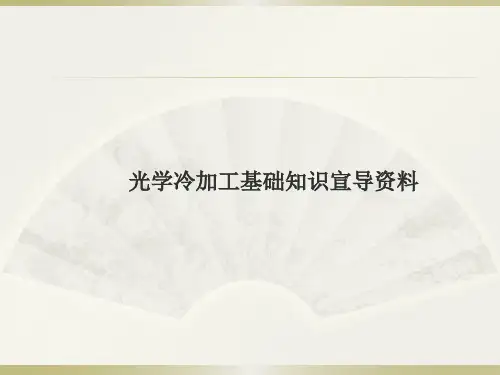
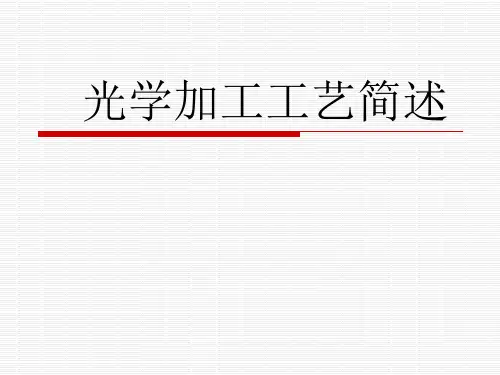
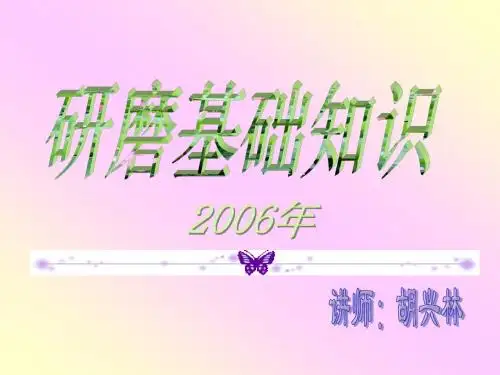
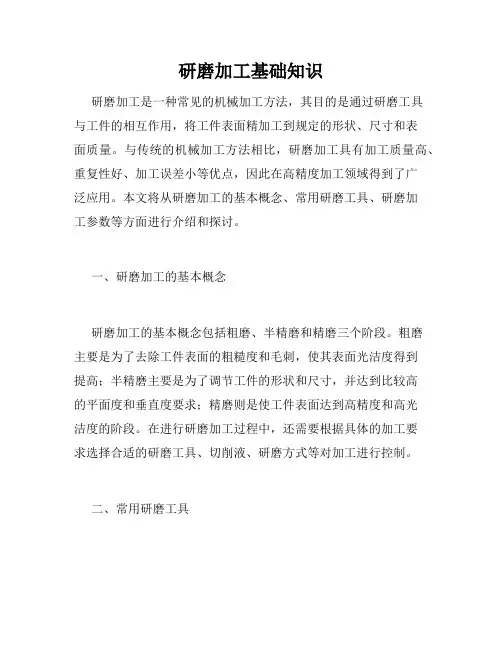
研磨加工基础知识研磨加工是一种常见的机械加工方法,其目的是通过研磨工具与工件的相互作用,将工件表面精加工到规定的形状、尺寸和表面质量。
与传统的机械加工方法相比,研磨加工具有加工质量高、重复性好、加工误差小等优点,因此在高精度加工领域得到了广泛应用。
本文将从研磨加工的基本概念、常用研磨工具、研磨加工参数等方面进行介绍和探讨。
一、研磨加工的基本概念研磨加工的基本概念包括粗磨、半精磨和精磨三个阶段。
粗磨主要是为了去除工件表面的粗糙度和毛刺,使其表面光洁度得到提高;半精磨主要是为了调节工件的形状和尺寸,并达到比较高的平面度和垂直度要求;精磨则是使工件表面达到高精度和高光洁度的阶段。
在进行研磨加工过程中,还需要根据具体的加工要求选择合适的研磨工具、切削液、研磨方式等对加工进行控制。
二、常用研磨工具研磨加工中常用的研磨工具有砂轮、砂带和砂纸等。
其中,砂轮是最常用的研磨工具,它主要由砂料、胶合剂和增强材料组成。
不同类型和规格的砂轮可以适用于不同的研磨任务,如平面研磨、内外圆研磨、表面抛光等。
砂带和砂纸则主要用于手工研磨和特殊形状的研磨。
三、研磨加工参数研磨加工的参数包括进给量、切削速度、砂轮转速等。
其中,进给量是指每次加工时工件与砂轮之间的距离,进给量的过大会导致加工过程中砂轮容易磨损,进给量间隔过小则会降低加工效率。
切削速度是指砂轮与工件表面之间相对运动的速度,它与砂轮的材料、粘结剂、砂料种类、砂轮的硬度、粒度等因素有关。
砂轮转速则是指砂轮转动的速度,它与砂轮的规格、材质、加工物件的材料、形状等因素有关。
四、研磨加工的技术难点研磨加工中存在一些技术难点,如研磨热引起的变形、整体划痕、砂轮寿命、表面拉伸等。
其中,研磨热引起的变形是由于研磨过程中产生的热量使工件表面材料的组织发生变化而引起的;整体划痕是指砂轮滑动时,在工件表面形成的较粗糙的划痕,一般是由进给量过大、砂轮胶结剂过硬、砂料过大等因素造成的;砂轮寿命和表面拉伸也是影响研磨加工的重要因素。
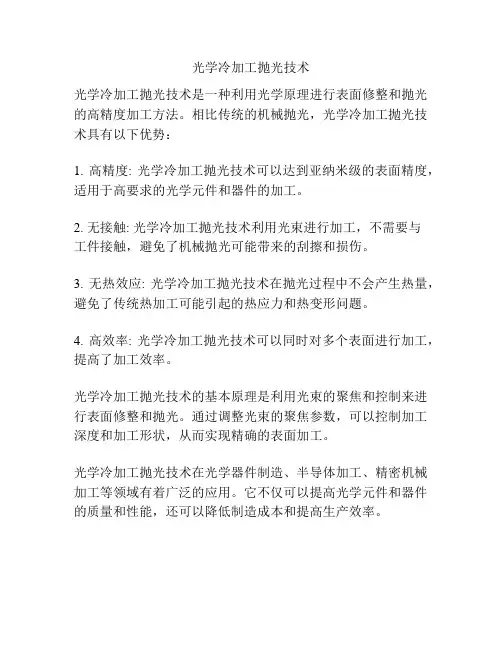
光学冷加工抛光技术
光学冷加工抛光技术是一种利用光学原理进行表面修整和抛光的高精度加工方法。
相比传统的机械抛光,光学冷加工抛光技术具有以下优势:
1. 高精度: 光学冷加工抛光技术可以达到亚纳米级的表面精度,适用于高要求的光学元件和器件的加工。
2. 无接触: 光学冷加工抛光技术利用光束进行加工,不需要与
工件接触,避免了机械抛光可能带来的刮擦和损伤。
3. 无热效应: 光学冷加工抛光技术在抛光过程中不会产生热量,避免了传统热加工可能引起的热应力和热变形问题。
4. 高效率: 光学冷加工抛光技术可以同时对多个表面进行加工,提高了加工效率。
光学冷加工抛光技术的基本原理是利用光束的聚焦和控制来进行表面修整和抛光。
通过调整光束的聚焦参数,可以控制加工深度和加工形状,从而实现精确的表面加工。
光学冷加工抛光技术在光学器件制造、半导体加工、精密机械加工等领域有着广泛的应用。
它不仅可以提高光学元件和器件的质量和性能,还可以降低制造成本和提高生产效率。
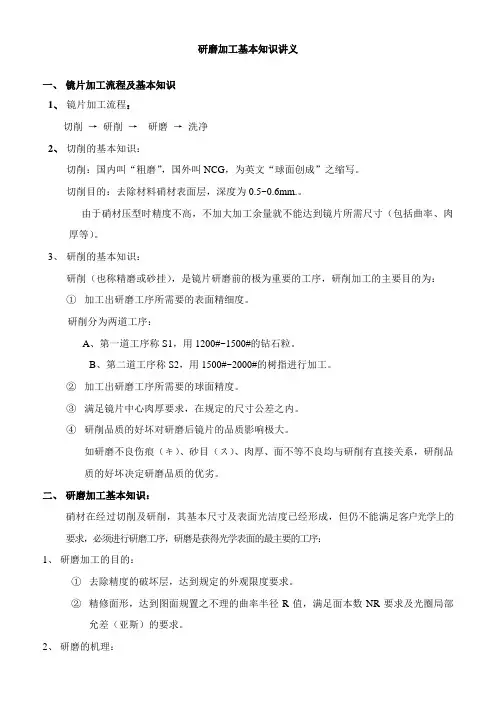
研磨加工基本知识讲义一、镜片加工流程及基本知识1、镜片加工流程:切削→研削→研磨→洗净2、切削的基本知识:切削:国内叫“粗磨”,国外叫NCG,为英文“球面创成”之缩写。
切削目的:去除材料硝材表面层,深度为0.5~0.6mm.。
由于硝材压型时精度不高,不加大加工余量就不能达到镜片所需尺寸(包括曲率、肉厚等)。
3、研削的基本知识:研削(也称精磨或砂挂),是镜片研磨前的极为重要的工序,研削加工的主要目的为:①加工出研磨工序所需要的表面精细度。
研削分为两道工序:A、第一道工序称S1,用1200#~1500#的钻石粒。
B、第二道工序称S2,用1500#~2000#的树指进行加工。
②加工出研磨工序所需要的球面精度。
③满足镜片中心肉厚要求,在规定的尺寸公差之内。
④研削品质的好坏对研磨后镜片的品质影响极大。
如研磨不良伤痕(キ)、砂目(ス)、肉厚、面不等不良均与研削有直接关系,研削品质的好坏决定研磨品质的优劣。
二、研磨加工基本知识:硝材在经过切削及研削,其基本尺寸及表面光洁度已经形成,但仍不能满足客户光学上的要求,必须进行研磨工序,研磨是获得光学表面的最主要的工序:1、研磨加工的目的:①去除精度的破坏层,达到规定的外观限度要求。
②精修面形,达到图面规置之不理的曲率半径R值,满足面本数NR要求及光圈局部允差(亚斯)的要求。
2、研磨的机理:①机械研削理论。
②化学学说。
③表面流动理论。
3、光圈的识别与度量(我们通常说的面即光圈)①什么是光圈?被检查镜片表面面形与标准曲率半径的原器面形有偏差时,它们之间含形成对称的契形空气间隙,从而形成等厚干涉条纹,有日光照射下可见到彩色光环(此时空气隙,呈环形对称),这种彩色的光环称为光圈,我们通常观察光圈数(即面本数)以红色光带为准。
这是因为红色光带较宽(波长范围为0.62um~0.78um),看起来清晰明亮。
②面本数的识别与度量有原器检查镜片时,如果二者是边缘接触(中间有空气层),从正方稍加压力P,干涉条纹从外向中心部移动即向内缩,称为低光圈或负光圈(图A),如果二者是从中间开始接触(边缘有空气隙),从正上方稍加压力P,干涉条纹从中心向边缘移动(或向外扩散)称为高光圈或正光圈(图B)③亚斯的识别与度量目前公司将面精度的中高、中低、垂边、分散或边等统称为亚斯,亚斯一定要满足作业标准的要求,超过标准含影响镜头的解像,所以亚斯是一个非常重要的指标,And grinding Basic knowledge handoutsLens processing processes and basic knowledge1, lens processing process:Wash cutting →grinding →grinding →2, the cutting of the basics:Cutting: Domestic called "coarse", abroad called the NCG, English spherical Creation "abbreviation.Cutting Objective: To remove the material the surface of the glass material layer and a depth of 0.5 to 0.6mm.Due to the type of glass material pressure accuracy is not high, do not increase the allowance can not be required to reach the lens size (including curvature, flesh, etc.).3, the grinding of the basics:Grinding (also known as grinding or sand hanging) is an extremely important step in front of the lens grinding Grinding main purpose:①machined surface fineness of the grinding step.Grinding is divided into two processes:A first process known as S1, 1200 # to 1500 # diamond particles.B, the second process known as S2, 1500 # ~ # 2000 resin processing.②processing spherical precision polishing step.(3) to meet the center of the lens flesh requirements within the specified dimensional tolerances.(4) grinding quality is good or bad quality of the lens grinding a great impact.Such as grinding bad scars (Cash), graining (su), flesh, ranging from bad to have a direct relationship with the grinding surface, the pros and cons of grinding quality determines the quality of the grinding quality.Grinding Basics:Nitrate material in its basic dimensions and surface finish has been formed after cutting and grinding, but it still can not meet the requirements of the customer optical polishing step mustbe carried out, is the most important step to obtain the optical surface polishing:1, the purpose of grinding:(1) removal of the accuracy of the destruction layer, to achieve the required appearance limit requirements.②the fine shave shaped to drawing requirements ignore the radius of curvature R, meet the requirements of the surface number NR requirements and aperture local tolerance (Elias).2, the grinding mechanism:①mechanical RESEARCH cut theory.(2) chemical theory.(3) surface flow theory.3, identification and measurement of the aperture (we usually say that the surface of the iris)①What is Aperture?Check the surface shape of the lens surface with the standard radius of curvature of the original surface shape deviation between them containing a symmetrical wedge-shaped air gap is formed, thereby forming fringes of equal thickness, the color can be seen under the sunlight halo (air gap annular symmetry), this halo of color called the iris aperture surface (the number), we usually observe the red band of light.This is because the red wide band of light (wavelength range 0.62um ~ 0.78um), looks clear and bright.②face identification and measurement of the number ofOriginal check lenses, if both the edge of the contact (the air layer in the middle), a little from the affirmative pressure P, interference fringes i.e. inwardly retracted portion moving from the center outward, as low the aperture or negative aperture (A) , if both are from the middle into contact with the air gap (edge), a little from the top of the positive pressure P, the interference fringes move from the center to the edge (or outward diffusion) called high aperture or positive aperture (Figure B)Determine the number of its surface is the red band of light as a standard vertical observation of several rings with that surface of the number of the Figure A Figure B is NR = -3, for NR = +3 this.(3) Elias identification and measurementSurface accuracy high, low, slouch, dispersed or side collectively referred to as Aspen, Aspen must meet the standard requirements of the job, more than the standard containing the impact of the resolution of the lens, so Aspen is a very important indicators。

1. 抛光粉1.1对抛光粉的要求a. 颗粒度应均匀,硬度一般应比被抛光材料稍硬:b. 抛光粉应纯洁,不含有可能引起划痕的杂质:c. 应具有一定的晶格形态和缺陷,并有适当的口锐性;d. 应具有良好的分散性和吸附性;e. 化学稳定性好,不致腐蚀工件。
1.2抛光粉的种类和性能常用的抛光粉有氧化肺<CeO2)和氧化铁(FeO3)oa. 氧化饰抛光粉颗粒呈多边形,棱角明显,平均直径约2微米,莫氏硬度7〜8级,比重约为7.3。
由于制造工艺和氧化饰含量的不同,氧化饰抛光粉有白色(含量达到98% 以上)、淡黄色、棕黄色等。
b. 氧化铁抛光粉俗称红粉,颗粒呈球形,颗粒大小约为0.5〜1微米,莫氏硕度4〜7 级,比重约为5.2。
颜色有从黄红色到深红色若干种。
综上所述,氧化饰比红粉具有更高的抛光效率,但是对表面光洁度要求高的零件,还是使用红粉抛光效果较好。
2. 抛光模层(下垫)材料常用的抛光模层材料有抛光胶和纤维材料。
2.1抛光胶抛光胶乂名抛光柏油,是由松香、沥青以不同的组成比例配制而成,用语光学零件的精密抛光。
2.2纤维材料在光学工件的抛光中,若对抛光面的面形精度(光圈)要求不高时,长采用呢绒、毛毡及其它纤维物质作为抛光模层的材料。
3•常用测试仪器光学委件的某些质量指标,如透镜的曲率半径、棱镜的角度,需耍用专门的测试仪器來测量。
常用的仪器有:光学比较侧角仪、激光平面干涉仪、球径仪和刀口仪等。
4.抛光在抛光过程中添加抛光液要适当。
太少了参与作用能够的抛光粉颗粒减少,降低抛光效率。
太多了,有些抛光粉颗粒并不参与工作,同时也带來大量液体使玻璃边面的温度下降,影响抛光效率。
抛光液的浓度也要适当,浓度太低,即水分太多,参与工作的抛光粉颗粒减少并使玻璃表面温度降低,因此降低抛光效率。
浓度太高,即水分带少,影响抛光压力,抛光粉不能迅速散步均匀,导致各部压力不等,造成局部多磨,对抛光的光圈(条纹)质量有影响。
而XI单位面积圧力减少,效率降低,抛光过程中产生的碎屑也不能顺利排除,使工件表面粗糙。

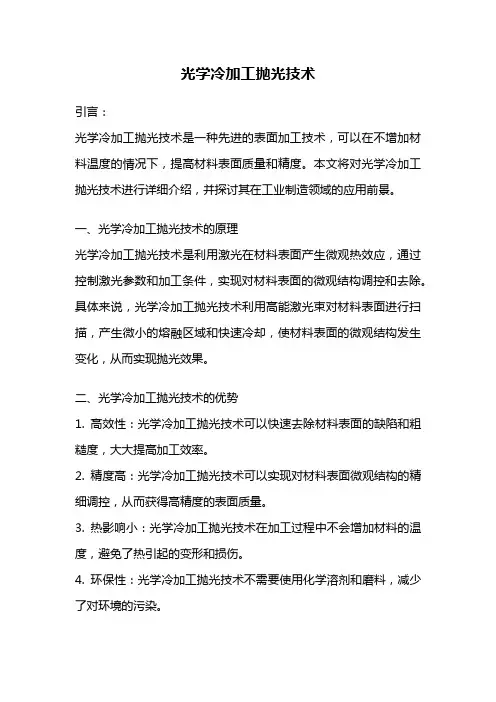
光学冷加工抛光技术引言:光学冷加工抛光技术是一种先进的表面加工技术,可以在不增加材料温度的情况下,提高材料表面质量和精度。
本文将对光学冷加工抛光技术进行详细介绍,并探讨其在工业制造领域的应用前景。
一、光学冷加工抛光技术的原理光学冷加工抛光技术是利用激光在材料表面产生微观热效应,通过控制激光参数和加工条件,实现对材料表面的微观结构调控和去除。
具体来说,光学冷加工抛光技术利用高能激光束对材料表面进行扫描,产生微小的熔融区域和快速冷却,使材料表面的微观结构发生变化,从而实现抛光效果。
二、光学冷加工抛光技术的优势1. 高效性:光学冷加工抛光技术可以快速去除材料表面的缺陷和粗糙度,大大提高加工效率。
2. 精度高:光学冷加工抛光技术可以实现对材料表面微观结构的精细调控,从而获得高精度的表面质量。
3. 热影响小:光学冷加工抛光技术在加工过程中不会增加材料的温度,避免了热引起的变形和损伤。
4. 环保性:光学冷加工抛光技术不需要使用化学溶剂和磨料,减少了对环境的污染。
三、光学冷加工抛光技术的应用领域1. 光学元件制造:光学冷加工抛光技术可以用于制造光学镜面、透镜等光学元件,提高其表面质量和光学性能。
2. 精密机械制造:光学冷加工抛光技术可以应用于精密机械零件的加工,如航空航天器件、半导体器件等,提高其表面质量和加工精度。
3. 光纤通信:光学冷加工抛光技术可以用于光纤端面的加工,提高光纤的传输效率和信号质量。
4. 光学薄膜涂层:光学冷加工抛光技术可以用于光学薄膜涂层的制备,提高薄膜的平整度和光学性能。
四、光学冷加工抛光技术的发展趋势1. 多波长激光应用:将多种波长的激光进行组合,可以实现对不同材料的高效抛光。
2. 全自动化加工系统:引入机器视觉和自动控制技术,实现光学冷加工抛光技术的全自动化生产。
3. 远程加工能力:通过激光束传输技术,实现对远程材料的抛光加工,拓展了应用范围。
4. 材料适应性提高:研发新的材料适应性加工方法,扩大光学冷加工抛光技术的适用范围。

光学加工工艺简介光学零件的加工,分为热加工、冷加工和特种加工,热加工目前多采用于光学零件的坯料备制;冷加工是以散粒磨料或固着磨料进行锯切、粗磨、精磨、抛光和定心磨边。
特种加工仅改变抛光表面的性能,而不改变光学零件的形状和尺寸,它包括镀膜、刻度、照相和胶合等。
冷加工各工序的主要任务是:粗磨(切削)工序:是使零件具有基本准确的几何形状和尺寸。
精磨(粗磨)工序:是使零件加工到规定的尺寸和要求,作好抛光准备。
抛光(精磨)工序:是使零件表面光亮并达到要求的光学精度。
定心工序:是相对于光轴加工透镜的外圆。
胶合工序:是将不同的光学零件胶合在一起,使其达到光轴重合或按一定方向转折。
球面光学零件现行加工技术三大基本工序为:1、范成法原理的铣磨(切削)2、压力转移原理的高速粗磨3、压力转移原理的高速抛光。
范成法原理的铣磨(切削),虽然加工效率较高,但其影响误差的因素较多,达到较高精度和较粗糙度较困难。
压力转移原理的准球心高速粗磨和高速抛光,零件受力较均匀,加工效率也较高,但必须预先准确修整磨(模)具的面形,才能保证零件的面形精度。
准确修整面形精度需要操作者的经验和技巧,而且需反复修整。
一、传统研磨与高速研磨特点1.传统研磨传统研磨也叫古典研磨,它是一种历史悠久的加工方法其主要特点是:(1)采用普通研磨机床或手工操作;(2)要求人员技术水平较高;(3)研磨材料多采用散砂(研磨砂)抛光沥青(4)抛光剂是用氧化铈或氧化铁;(5)压力用加荷重方法实现虽然这种方法效率低, 但加工精度较高所以,目前仍被采用。
2.高速研磨抛光一般是指准球心法(或称弧线摆动法)。
其主要特点是:(1)采用高速、高压和更有效的利用抛光模,大大提高了抛光效率(2)压力头围绕球心做弧线摆动,工作压力始终指向球心,也是靠球模成型的。
3.范成法准球心法对机床的精度要求较低,加工方法和传统法相近,易于实现,用的较广;范成法对机床精度及调整要求较高,目前很少采用。
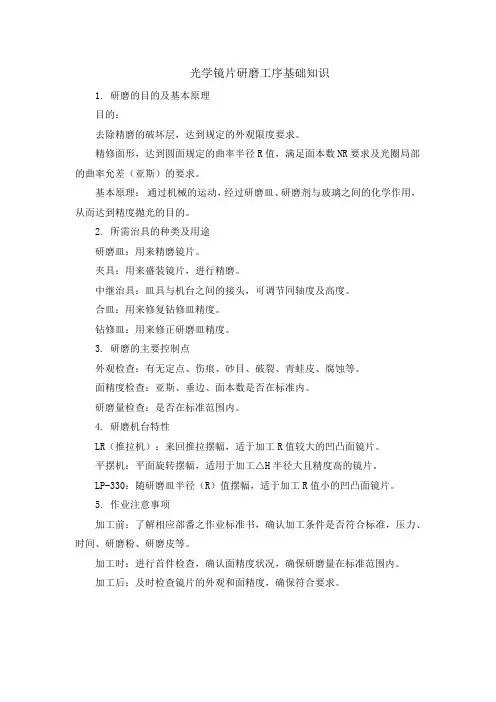
光学镜片研磨工序基础知识
1. 研磨的目的及基本原理
目的:
去除精磨的破坏层,达到规定的外观限度要求。
精修面形,达到圆面规定的曲率半径R值,满足面本数NR要求及光圈局部的曲率允差(亚斯)的要求。
基本原理:通过机械的运动,经过研磨皿、研磨剂与玻璃之间的化学作用,从而达到精度抛光的目的。
2. 所需治具的种类及用途
研磨皿:用来精磨镜片。
夹具:用来盛装镜片,进行精磨。
中继治具:皿具与机台之间的接头,可调节同轴度及高度。
合皿:用来修复钻修皿精度。
钻修皿:用来修正研磨皿精度。
3. 研磨的主要控制点
外观检查:有无定点、伤痕、砂目、破裂、青蛙皮、腐蚀等。
面精度检查:亚斯、垂边、面本数是否在标准内。
研磨量检查:是否在标准范围内。
4. 研磨机台特性
LR(推拉机):来回推拉摆幅,适于加工R值较大的凹凸面镜片。
平摆机:平面旋转摆幅,适用于加工△H半径大且精度高的镜片。
LP-330:随研磨皿半径(R)值摆幅,适于加工R值小的凹凸面镜片。
5. 作业注意事项
加工前:了解相应部番之作业标准书,确认加工条件是否符合标准,压力、时间、研磨粉、研磨皮等。
加工时:进行首件检查,确认面精度状况,确保研磨量在标准范围内。
加工后:及时检查镜片的外观和面精度,确保符合要求。
实验二十五放大镜的制作第一章光学零件制造工艺一般知识1.1 光学零件制造工艺的特点及一般过程制作光学零件的常见材料有三大类,即光学玻璃、光学晶体和光学塑料,其中以光学玻璃,特别是无色光学玻璃的使用量最大。
虽然光学零件的加工按行业划分归入机械加工一类,但由于加工对象的材料性质和加工精度要求显著地不同于金属材料,因而加工工艺上也完全不同于金属工艺而具有特殊性。
1.1.1 光学零件的加工精度及其表示光学零件属于高精度零件。
平面零件的加工精度主要有角度和平面面形;球面零件的加工精度要求主要有曲率半径和球面面形。
高精度棱镜的角误差要求达到秒级。
高精度平面面形精度可达到几十分之一到几百分之一波长。
平面零件的平面性和球面零件的球面性统一称为面形要求。
光学车间一般用干涉法计量,用样板叠合观察等厚干涉条纹(俗称看光圈)。
表示面形误差的光圈数符号是N,不规则性(或称局部误差)符号是△N。
除面形精度外,光学零件表面还要有粗糙度要求。
光学加工中各工序的表面粗糙度如表6-1所示。
光学零件抛光表面粗糙度用微观不平十点高度表示为R2=0.025um,用轮廓算术平均偏差表示为R2=0.025um,用符号表示则为0.008,在此基础上,还有表面疵病要求,即对表面亮丝、擦痕、麻点的限制。
1.1.2 光学零件加工的一般工艺过程及特点光学零件加工的工艺过程随加工方式不同而异。
光学零件的加工方式主要有两类:传统(古典)加工工艺和机械化加工工艺,这里我们只介绍传统加工工艺。
传统工艺的特点主要有:(1)使用散粒磨料及通用机床,以轮廓成形法对光学玻璃进行研磨加工。
操作中以松香柏油粘结胶为主进行粘结上盘。
先用金刚砂对零件进行粗磨与精磨,然后使用松香柏油抛光模与抛光粉(主要是氧化铈)对零件进行抛光加工。
影响工艺的因素多而易变,加工精度可变性也大,通常是几个波长数量级。
高精度者可达几百分之一波长数量级。
(2)手工操作量大,工序多,操作人员技术要求高。
光学冷加工抛光技术光学冷加工抛光技术是一种利用光学原理进行表面加工的技术。
它通过利用光束的特性,对材料表面进行微小的位移和热效应,从而达到加工和抛光的目的。
这种技术具有高效、精确、无损伤等优点,在光学制造、精密加工、光学器件等领域具有广泛的应用前景。
光学冷加工抛光技术的原理是利用光束的特性对材料表面进行微小的位移。
光束通过加工头的透镜系统聚焦到材料表面上,形成一个微小的光斑。
当光斑移动时,光束对材料产生作用力,使材料表面产生微小的位移。
通过控制光斑的移动,可以实现对材料表面的加工和抛光。
光学冷加工抛光技术的另一个原理是利用光束的热效应。
光束在材料表面吸收时会产生热效应,使材料发生热膨胀。
通过控制光束的功率和时间,可以实现对材料表面的加工和抛光。
光学冷加工抛光技术具有许多优点。
首先,它是一种非接触的加工方法,不会对材料产生机械性损伤。
其次,它具有高效的加工速度和精确的加工控制能力,可以实现对复杂形状的材料进行加工和抛光。
此外,光学冷加工抛光技术还可以实现对材料表面的微观加工,使其具有更好的表面质量。
光学冷加工抛光技术在光学制造领域具有广泛的应用。
例如,在光学镜片的制造过程中,通过使用光学冷加工抛光技术可以实现对镜片表面的加工和抛光,使其具有更好的光学性能。
在激光器的制造过程中,光学冷加工抛光技术可以实现对激光器的反射镜表面的加工和抛光,提高激光器的效率和稳定性。
在光学器件的制造过程中,光学冷加工抛光技术可以实现对光学器件的表面的微观加工,提高器件的性能和可靠性。
光学冷加工抛光技术在精密加工领域也具有重要的应用价值。
例如,在微机电系统的制造过程中,光学冷加工抛光技术可以实现对微小器件的表面的加工和抛光,提高器件的性能和可靠性。
在半导体器件的制造过程中,光学冷加工抛光技术可以实现对半导体器件的表面的微观加工,提高器件的效率和稳定性。
此外,光学冷加工抛光技术还可以应用于金属材料的加工和抛光,提高金属材料的表面质量和耐蚀性。
光学冷加工的基础介绍摘要:本文介绍了光学冷加工的含义、特点并简单介绍了相关的一些产品,机器及其图形,本文详细论述了光学冷加工的加工过程(以球面透镜的加工为例)以及当前我国光学冷加工所存在的问题和提出了发展对策,并指出光学冷加工工艺对社会的重要性。
关键词:光学冷加工,球形透镜,毛坯加工,抛光。
Abstract: This article describes the meaning and the characteristics of the optical cold Processing, introducing a number of related products, machinery and graphics, briefly. The paper also discusses the process cold optics in details (spherical lens processing as an example),and refers to the questions in our country ’s optical cold Processing, Including the method of development, the importance of the optical cold Processing technology is also pointed out.一、光学冷加工的含义光学仪器制造已是一门古老的工程技术,照相机、望远镜及其显微镜等各种光学仪器中的光学零件(透镜,棱镜等)在加工过程中,不产生高温及高温反映或高温现象而又可以达到通过高温热加工的加工效果就称为“光学冷加工”。
下面是几种光学冷加工的产品:二、光学冷加工的特点1、光学冷加工与一般的机械加工有根本的区别,这些差别是由被加工材料的性能特殊及零件要求特别高的精度和光洁度所决定的.由于零件是以玻璃为原材料,它具有很高的硬度和脆性,因此,必须用比玻璃还硬的金刚砂或金刚钻来加工玻璃。
光学零件加工-------精磨技术
精磨是光学冷加工很重要的工序,其目的是修正前道铣磨的参数,并使工件达到抛光前所需的面形精度、尺寸精度和表面粗糙度。
一、影响镜片面型的因素
(1)磨具
磨具的面型高,则镜片低。
反之,则高。
(2)顶针
顶针向外放,则面型变低,反之,则高。
(3)摆幅
摆幅主要保证镜片的磨耗面积,使面型整体变化小。
(4)角度
角度大,面型容易变低,反之,则高。
(但随着其他参数的变化,会有所不同,因此,要看操作者的经验是否丰富)。
二、影响表面的因素
(1)磨具表面不好,需要修复。
(2)精磨冷却液浓度低或使用时间过长,参杂玻璃碎末太多。
(3)玻璃在铣磨时的尺寸不好。
(4)丸片受损或漏胶。
三、修模具的方法
如果镜片面型高,磨具在上-----则小摆,磨具在下------则大摆。
如果镜片面型低,磨具在上-----则大摆,磨具在下------的小摆。
研磨加工基本知识讲义一、镜片加工流程及基本知识1、镜片加工流程:切削→研削→研磨→洗净2、切削的基本知识:切削:国内叫“粗磨”,国外叫NCG,为英文“球面创成”之缩写。
切削目的:去除材料硝材表面层,深度为0.5~0.6mm.。
由于硝材压型时精度不高,不加大加工余量就不能达到镜片所需尺寸(包括曲率、肉厚等)。
3、研削的基本知识:研削(也称精磨或砂挂),是镜片研磨前的极为重要的工序,研削加工的主要目的为:①加工出研磨工序所需要的表面精细度。
研削分为两道工序:A、第一道工序称S1,用1200#~1500#的钻石粒。
B、第二道工序称S2,用1500#~2000#的树指进行加工。
②加工出研磨工序所需要的球面精度。
③满足镜片中心肉厚要求,在规定的尺寸公差之内。
④研削品质的好坏对研磨后镜片的品质影响极大。
如研磨不良伤痕(キ)、砂目(ス)、肉厚、面不等不良均与研削有直接关系,研削品质的好坏决定研磨品质的优劣。
二、研磨加工基本知识:硝材在经过切削及研削,其基本尺寸及表面光洁度已经形成,但仍不能满足客户光学上的要求,必须进行研磨工序,研磨是获得光学表面的最主要的工序:1、研磨加工的目的:①去除精度的破坏层,达到规定的外观限度要求。
②精修面形,达到图面规置之不理的曲率半径R值,满足面本数NR要求及光圈局部允差(亚斯)的要求。
2、研磨的机理:①机械研削理论。
②化学学说。
③表面流动理论。
3、光圈的识别与度量(我们通常说的面即光圈)①什么是光圈?被检查镜片表面面形与标准曲率半径的原器面形有偏差时,它们之间含形成对称的契形空气间隙,从而形成等厚干涉条纹,有日光照射下可见到彩色光环(此时空气隙,呈环形对称),这种彩色的光环称为光圈,我们通常观察光圈数(即面本数)以红色光带为准。
这是因为红色光带较宽(波长范围为0.62um~0.78um),看起来清晰明亮。
②面本数的识别与度量有原器检查镜片时,如果二者是边缘接触(中间有空气层),从正方稍加压力P,干涉条纹从外向中心部移动即向内缩,称为低光圈或负光圈(图A),如果二者是从中间开始接触(边缘有空气隙),从正上方稍加压力P,干涉条纹从中心向边缘移动(或向外扩散)称为高光圈或正光圈(图B)③亚斯的识别与度量目前公司将面精度的中高、中低、垂边、分散或边等统称为亚斯,亚斯一定要满足作业标准的要求,超过标准含影响镜头的解像,所以亚斯是一个非常重要的指标,And grinding Basic knowledge handoutsLens processing processes and basic knowledge1, lens processing process:Wash cutting →grinding →grinding →2, the cutting of the basics:Cutting: Domestic called "coarse", abroad called the NCG, English spherical Creation "abbreviation.Cutting Objective: To remove the material the surface of the glass material layer and a depth of 0.5 to 0.6mm.Due to the type of glass material pressure accuracy is not high, do not increase the allowance can not be required to reach the lens size (including curvature, flesh, etc.).3, the grinding of the basics:Grinding (also known as grinding or sand hanging) is an extremely important step in front of the lens grinding Grinding main purpose:①machined surface fineness of the grinding step.Grinding is divided into two processes:A first process known as S1, 1200 # to 1500 # diamond particles.B, the second process known as S2, 1500 # ~ # 2000 resin processing.②processing spherical precision polishing step.(3) to meet the center of the lens flesh requirements within the specified dimensional tolerances.(4) grinding quality is good or bad quality of the lens grinding a great impact.Such as grinding bad scars (Cash), graining (su), flesh, ranging from bad to have a direct relationship with the grinding surface, the pros and cons of grinding quality determines the quality of the grinding quality.Grinding Basics:Nitrate material in its basic dimensions and surface finish has been formed after cutting and grinding, but it still can not meet the requirements of the customer optical polishing step mustbe carried out, is the most important step to obtain the optical surface polishing:1, the purpose of grinding:(1) removal of the accuracy of the destruction layer, to achieve the required appearance limit requirements.②the fine shave shaped to drawing requirements ignore the radius of curvature R, meet the requirements of the surface number NR requirements and aperture local tolerance (Elias).2, the grinding mechanism:①mechanical RESEARCH cut theory.(2) chemical theory.(3) surface flow theory.3, identification and measurement of the aperture (we usually say that the surface of the iris)①What is Aperture?Check the surface shape of the lens surface with the standard radius of curvature of the original surface shape deviation between them containing a symmetrical wedge-shaped air gap is formed, thereby forming fringes of equal thickness, the color can be seen under the sunlight halo (air gap annular symmetry), this halo of color called the iris aperture surface (the number), we usually observe the red band of light.This is because the red wide band of light (wavelength range 0.62um ~ 0.78um), looks clear and bright.②face identification and measurement of the number ofOriginal check lenses, if both the edge of the contact (the air layer in the middle), a little from the affirmative pressure P, interference fringes i.e. inwardly retracted portion moving from the center outward, as low the aperture or negative aperture (A) , if both are from the middle into contact with the air gap (edge), a little from the top of the positive pressure P, the interference fringes move from the center to the edge (or outward diffusion) called high aperture or positive aperture (Figure B)Determine the number of its surface is the red band of light as a standard vertical observation of several rings with that surface of the number of the Figure A Figure B is NR = -3, for NR = +3 this.(3) Elias identification and measurementSurface accuracy high, low, slouch, dispersed or side collectively referred to as Aspen, Aspen must meet the standard requirements of the job, more than the standard containing the impact of the resolution of the lens, so Aspen is a very important indicators。